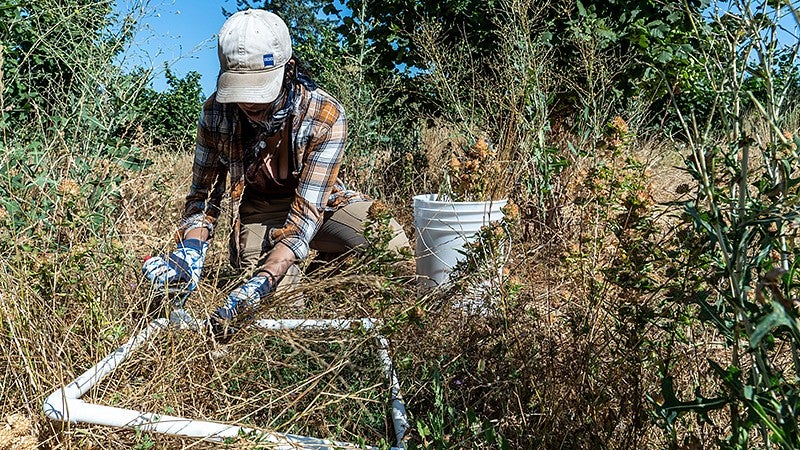Among the bright, leafy hazelnut trees of Dorris Ranch, Jazz Dhillon tosses a PVC pipe frame into the air. She kneels down where the pipe frame lands, cuts all the plants in the frame, and puts them in a white bucket.
Dhillon, the lab manager for the Hallett Lab in the Department of Biology and the Environmental Studies Program, is collecting samples to test a new, more sustainable way to farm hazelnuts. The lab is part of the UO’s College of Arts and Sciences.

Normally, there wouldn’t be plants to cut. Hazelnut farmers in the United States intensively mow and apply pesticides to their orchards to create smooth ground where it’s easier to harvest nuts. Steve Haring, a postdoctoral researcher in the Hallett Lab, is studying what happens when cover crops, such as native wildflowers, are used as beds around the trees.
On other kinds of farms, cover crops have helped diversify ecosystems, store carbon in the soil, attract pollinators, reduce weeds and retain water in the soil. And if they are mowed before harvest, they still leave smooth ground for farmers.
Oregon produces 99 percent of hazelnuts in the U.S., and more and more farms in the Willamette Valley are shifting to hazelnuts because they require less management than annual crops, with technical support to grow them and more markets in which to sell them.
Starting in 2019, Haring and Marissa Lane-Massee, a master’s student in the Hallett lab, created plots at two farms: Dorris Ranch, a working hazelnut orchard in Springfield contained within a public park, and an orchard near Keizer, Oregon, owned by Massee’s family. Haring has 12 plots at Dorris Ranch: four plots with no cover crops, four with a commercial plant mix, and four with a native plant mix.
After Dhillon hands the bucket to Haring, he sorts the plants into weeds and the species they planted. He is observing features that are important to farmers, such as the weight of weeds and the species he planted, the number of pests, and the amount of water in the soil.
To adopt cover crops, “there has to be some advantage for the farmer,” said Lynnea Lane, who co-owns the orchard near Keizer.
While Haring is gathering evidence that cover crops, especially native cover crops, are a more sustainable approach for hazelnut orchards, it doesn’t make economic sense for farmers yet. Paul Massee, who co-owns the Keizer orchard with Lane, said it’s still a work in progress, and he is eager to find out where it goes.
“We do this to better the industry in some way,” Massee said. “Will it be a practice that we use later on? I don’t know. But if we don’t try, we’ll never know.”
—Story and photos by Vishva Nalamalapu, College of Arts and Sciences


